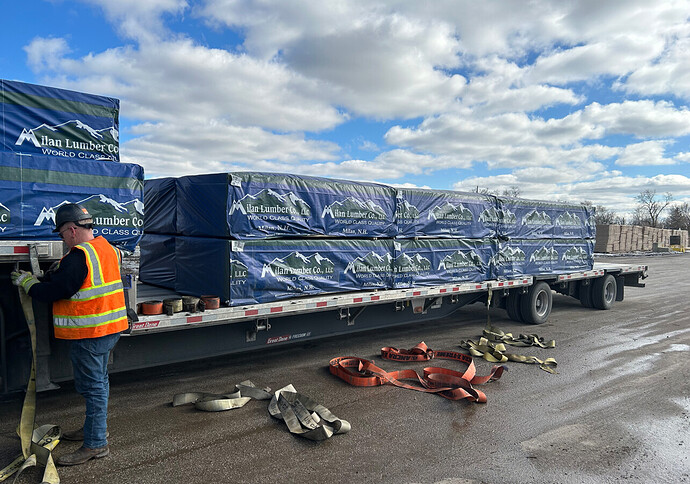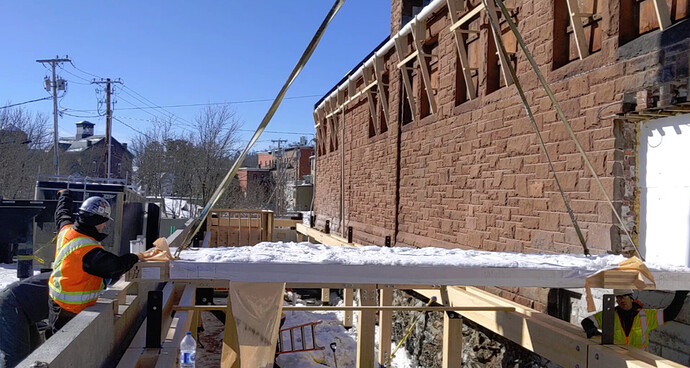University of New Hampshire Cooperative Extension has embarked on a project that could be a boost both to the region’s timber industry and the ongoing efforts to fight climate change.
The project revolves around studying how softwoods that grow in the Northern Forest – an area that includes New Hampshire, Maine, Vermont and New York – can be used in the growing trend toward use of cross-laminated timber in so-called mass timber construction, which involves use of an engineered wood panel that is typically up to 50 feet long, 2 to 10 feet wide and up to 14 inches thick.
To produce cross-laminated timber, or CLT, two-inch boards are glued together, with each layer turned 90 degrees from the adjacent layers. CLT is typically 3 to 9 layers thick depending on its application and required strength. The resulting panels are fastened together. The result is a product with “strength, beauty, lightweight, mechanical characteristics, and stored carbon (that) make it a versatile building material that can displace fossil fuel-intensive building materials such as concrete and steel,” said Andrew Fast, Forest Industry State Specialist for UNH Cooperative Extension,.
Fast is overseeing the Northern Forests project, which aims to test and certify the region’s softwoods to make CLT panels composed of wood from New Hampshire and surrounding areas available to builders at a cost-effective price.
“If all goes to plan, CLT made from local species sourced from our region should be available to builders in the third or fourth quarter of 2023,” said Fast.
“This project could be a catalyst for a significant new wood market in the region,” said Joe Short, vice president of the Northern Forest Center, which manages the Future Forest Economy Initiative. “If building designers respond by seeking this CLT made from regional wood, it could help accelerate investment in CLT manufacturing capacity in the region, opening a up a new market for wood and supporting more mass timber construction.”
The project to test CLT from the region’s Spruce-Pine-Fir, known as SPFs, is made possible through the Future Forest Economy Initiative as part of its $ 3 million effort to expand markets for the region’s wood supply.
The initiative – a joint effort of the U.S. Economic Development Administration, U.S. Endowment for Forestry & Communities and the Northern Forest Center – supports development of new markets for wood from the Northern Forest to support the region’s economy and maintain the forests.
The pilot is starting at Milan Lumber in the Coos County town of Milan, which won the contract to mill the local timber that was then dried and sent to Sterling Structural, a CLT mass timber manufacturer in Illinois. Sterling will produce CLT panels and ship them to the University of Maine, where they will be tested to ensure they meet the standards for cross-laminated timber, which are known as PRG-320 requirements for strength, fire resistance, and other qualities.
“It’s really exciting,” said Fast. “There is tremendous interest from the building community to use CLT made from local species. This project will strengthen the supply chain and allow forest product entrepreneurs to scale up as demand for this product increases in the region.”
Testing is scheduled for May, after which a certifying body will write the formal certification and the panels will be available for purchase and use in mass timber construction in the Northeast, he said.
Sterling is already a certified manufacturer of cross-laminated timber. Both the manufacturer and the products must be certified.
After certification, wood from New England forests can go to Sterling Structural to be manufactured into CLT panels for buildings constructed in New England communities.
“Eventually, the hope is that demand for northeastern CLT will catalyze a company like Sterling to manufacture the product in the region,” said Short.
“This is a huge step toward more CLT construction in the Northeast and to having locally based manufacturers,” said Fast. “Once the demand grows strong enough, we hope that will be incentive for a manufacturer to build a facility here to use local species and serve the Northeast market.”
“We get a double climate benefit when we use mass timber,” said Short. “The panels lock up and store carbon for their entire life, which could easily be 100 years or more, and they displace products that have much larger carbon footprints.”
said Fast.
“If we can get CLT certified and off the ground using timber from the well-managed forests in the Northeast, we’ll be tapping into a whole new market for our forests to serve that has the dual benefit of reducing the carbon footprint of construction by displacing petroleum-based building materials,”
In conjunction with the current project, UNH is collaborating with the U.S. Forest Service, the state of Massachusetts, and the North East State Foresters Association to qualify eastern hemlock CLT at the Sterling Structural plant.
Source: UNH project testing use of regional softwood in mass timber construction - NH Business Review

